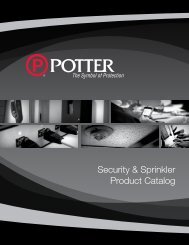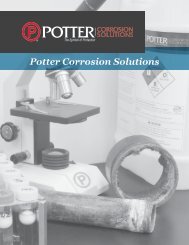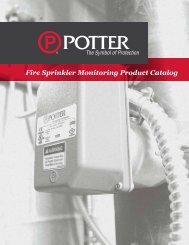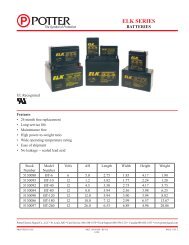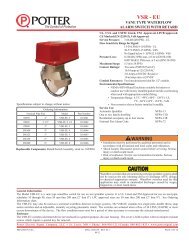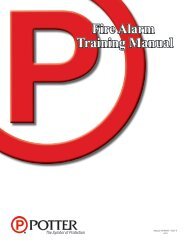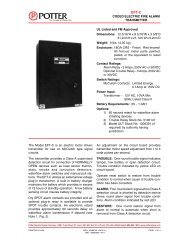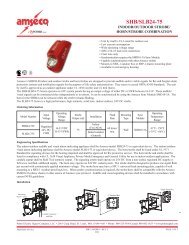Training Manual - Potter Electric Signal Company, LLC
Training Manual - Potter Electric Signal Company, LLC
Training Manual - Potter Electric Signal Company, LLC
Create successful ePaper yourself
Turn your PDF publications into a flip-book with our unique Google optimized e-Paper software.
A) Beam Construction - Ceilings having solid nonstructural members projecting down from the ceiling surface<br />
more than 4 in. and spaced more than 3 ft., center to center.<br />
B) Girders - Girders support beams or joists and run at right angles to the beams or joists. When the top of girders<br />
are within 4 in. of the ceiling, they are a factor in determining the number of detectors and are to be considered as<br />
beams. When the top of the girder is more than 4 in. from the ceiling, it is not a factor in detector location. Check<br />
Valve - A self-operating valve that is used to prevent reverse flow through any portion of the system.<br />
Central Station - A supervising station that is listed for central station service.<br />
Central Station Fire Alarm System - A system or group of systems in which the operations of circuits and<br />
devices are transmitted automatically to, recorded in, maintained by, and supervised from a listed central station.<br />
Class A Circuit - Class A refers to an arrangement of monitored initiating device, signaling line, or notification<br />
appliance circuits, which would permit a single open or ground on the installation wiring of these circuits from<br />
causing loss of the systems intended function.<br />
Class B Circuit - Class B refers to an arrangement of monitored initiating device, signaling line, or notification<br />
appliance circuits, which would permit a single open or ground on the installation wiring of these circuits to<br />
cause loss of the systems intended function.<br />
Combination Detector - A device that either responds to more than one fire phenomenon or employes more<br />
than one operating principle to sense one of these phenomenon. Typical examples are combination smoke/heat<br />
detectors or a combination rate of rise and fixed temperature heat detector.<br />
Compatibility Listed - A specific listing process that applies only to two wire devices [such as smoke<br />
detectors] designed to operate with certain control equipment.<br />
Control Valve - A valve controlling flow to water-based fire protection systems. Control valves do not include<br />
hose valves, inspector’s test valves, drain valves, trim valves for dry pipe, pre-action and deluge valves, check<br />
valves, or relief valves.<br />
Digital Alarm Communicator Receiver [DACR] - A system component that will accept and display signals<br />
from digital alarm communicator transmitters [DACT] sent over public switched telephone network.<br />
Digital Alarm Communicator System [DACS] - A system in which signals are transmitted from a digital<br />
alarm communicator transmitter [DACT] located at the protected premises through the public switched<br />
telephone network to a DACR.<br />
Digital Alarm Communicator Transmitter [DACT] - A system component at the protected premises to<br />
which initiating devices are connected. The DACT will seize the connected telephone line, dial a pre-selected<br />
telephone number to connect to a DACR, and transmit signals indicating a status change of the initiating device.<br />
Display - The visual representation of output data other than printed copy.<br />
Dry Pipe Sprinkler System - A sprinkler system employing automatic sprinklers that are attached to a piping<br />
system containing air or nitrogen under pressure, the release of which (as from the opening of a sprinkler)<br />
permits the water pressure to open a valve known as a dry pipe valve, and the water then flows into the piping<br />
system and out the opened sprinklers.<br />
End Of Line Device - A device such as a resistor or diode placed at the end of a class B circuit to maintain supervision<br />
End Of Line Relay - A device used to supervise power [usually for 4-wire smoke detectors] and installed<br />
within or near the last device on an initiating circuit.<br />
Evacuation - The withdrawal of occupants from a building. Note: Evacuation does not include relocation of<br />
occupants within a building.<br />
Evacuation <strong>Signal</strong> - Distinctive signal intended to be recognized by the occupants as requiring evacuation of<br />
the building.<br />
Exit Plan - Plan for the emergency evacuation of the premises.<br />
Fire Alarm Control Unit [Panel] - A system component that receives inputs from automatic and manual fire<br />
alarm devices and may supply power to detection devices and transponders or off-premises transmitters. The<br />
control unit may also provide transfer of power to the notification appliances and transfer condition of relays or<br />
devices connected to the control unit. The fire alarm control unit can be a local unit or a master control unit.<br />
Fire Rating - The classification indicating in time [hours] the ability of a structure or component to withstand<br />
fire conditions.<br />
Fire Safety Functions - Building and fire control functions that are intended to increase the level of life safety<br />
for occupants or to control the spread of harmful effects of fire.<br />
Flame Detector - A device that detects the infrared, ultraviolet, or visible radiation caused by fire.<br />
Four Wire Smoke Detector - A smoke detector which initiates an alarm condition on two separate wires<br />
[initiating circuit] separate from the two power leads.<br />
Heat Detector - A device that detects abnormally high temperature or rate of temperature rise.<br />
Initiating Device - A system component that originates transmission of a change of state condition, such as a<br />
smoke detector, water flow switch, etc.<br />
Initiating Device Circuit - A circuit to which automatic or manual initiating devices are connected.<br />
Ionization Smoke Detector - A smoke detector that has a small amount of radioactive material which ionizes<br />
the air in the sensing chamber, thus rendering it conductive and permitting a current to flow between two<br />
charged electrodes. This gives the sensing chamber an effective electrical conductance. When smoke particles<br />
enter the sensing chamber they decrease the conductance of the air by attaching themselves to the ions, causing<br />
a reduction in mobility. When conductance is reduced to less than a predetermined level, the detector responds.<br />
Level Ceilings - Those ceilings that are actually level or have a slope of less than 1½ in. per foot.<br />
Light Scattering - The action of light being reflected and/or refracted off particles of combustion for detection<br />
by a photoelectric smoke detector.<br />
Line Type Detector - A device in which detection is continuous along a path. Examples include projected beam<br />
smoke detectors and heat sensitive cable.<br />
Listed - Equipment or materials included in a list published by an organization acceptable to the “authority<br />
having jurisdiction” and concerned with product evaluation, that maintains periodic inspection of production of<br />
listed equipment or materials and whose listing states either that the equipment or material meets appropriate<br />
standards or has been tested and found suitable for use in a specific manner. Note: The means for identifying<br />
listed equipment may vary for each organization concerned with product evaluation, some of which do not<br />
recognize as listed unless it is also labeled. The “authority having jurisdiction” should utilize the system<br />
employed by the listing organization to identify a listed product.<br />
Local Fire Alarm System - A local system sounding an alarm at the protected premises as the result of the<br />
operation of automatic or manual initiating devices.<br />
<strong>Manual</strong> Station [pull station] - A manually operated device used to initiate an alarm signal.<br />
National <strong>Electric</strong>al Manufacturers Association [NEMA] - is a U.S. trade organization representing<br />
manufacturers of products used in the generation, transmission, distribution, control, and end-use of electricity. Many<br />
of NEMA’s standards have been approved as American National Standards or adopted by the federal government.<br />
6 7



